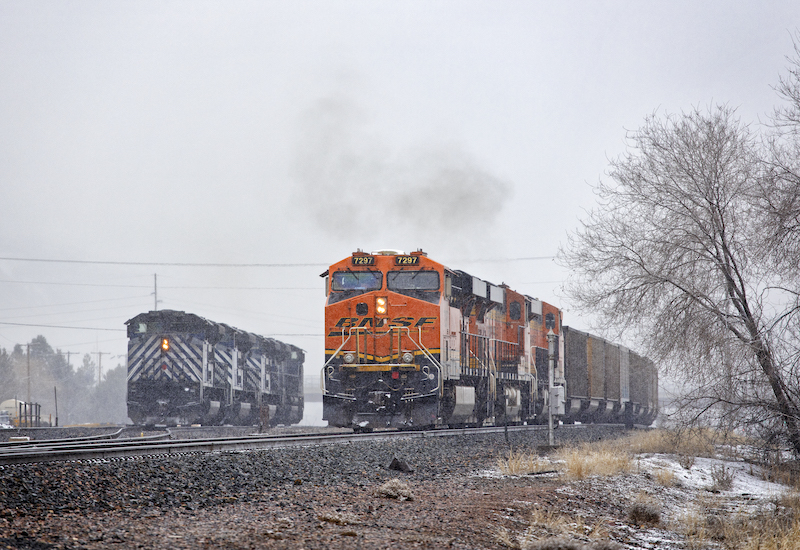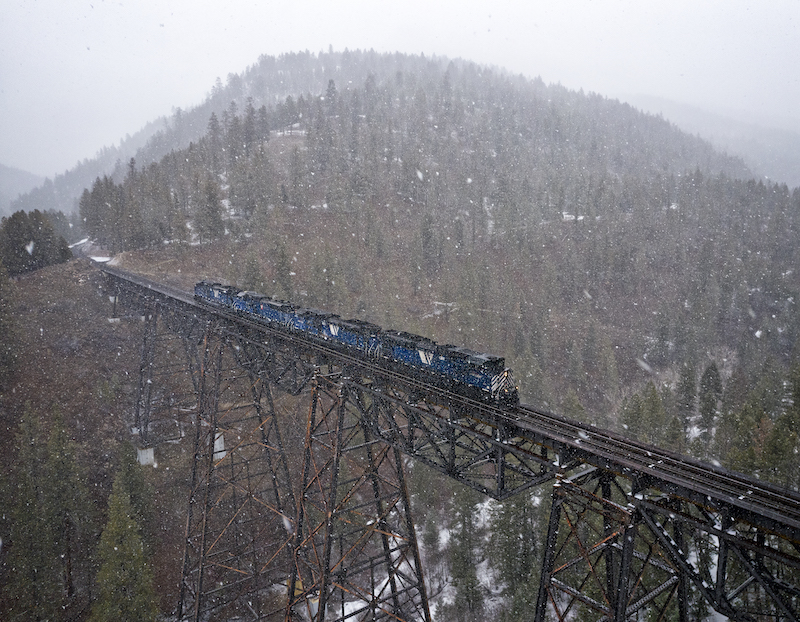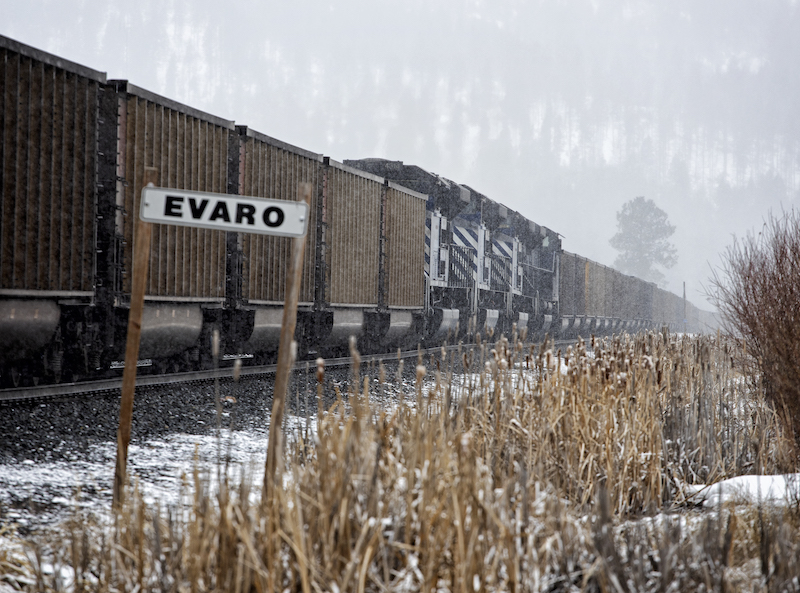By Justin Franz
EVARO, Mont. — For those floating Montana’s oft-pristine waters, there’s nothing more rewarding than finding a river-chilled beer shimmering from below; possibly dropped by another boater or rafter on a previous expedition. But on Sunday, April 2, boater Stephen Smith floated up to the motherlode after a reefer involved with a derailment on Montana Rail Link’s 4th Subdivision near Paradise, Mont., spilled its contents — mostly cases of Coors Light and Blue Moon — all over the banks of the Clark Fork River. The image of Smith joyfully hoisting his prize would ricochet across social media in the days that followed.
But about 50 miles east, a few lucky railfans found another prize in the days after the April 2 derailment, as MRL was forced to detour traffic via the 2.2 percent Evaro Hill, requiring the use of manned helpers out of Missoula for the first time in nearly a decade.

BNSF Railway C-BTMRBA007 passes a four-unit helper set at West Missoula on Monday, April 3. The helpers would cut into the middle of the westbound coal train for the trip up Evaro Hill. Photo by Justin Franz.
Evaro Hill is often overshadowed by MRL’s other mountain grades further east, the 2.2 percent Mullan Pass and the 1.9 percent Bozeman Pass, both of which require manned helpers to move tonnage over. The route over Evaro was constructed in 1883 as part of Northern Pacific’s original main line. While the routing expeditiously brought the railroad to the banks of the Flathead River near Dixon, which along with the Clark Fork River, it could follow all the way to Sandpoint, Idaho, it required a tough climb just west of Missoula. But within a few years, one of the NP’s chief engineers called the Evaro routing a “great mistake.” In 1890, NP built a branch west of Missoula along the Clark Fork River toward the mining town of Wallace, Idaho. At St. Regis, where the branch left the river and turned toward the Bitterroot Mountains, the rails were just 22 miles upriver from the original main line. In 1909, the NP decided to finally correct its Evaro “mistake” and built a cutoff between St. Regis and Paradise. The Clark Fork River route was longer by 30 miles but it was easier and so the NP sent freights along it and kept passenger trains and locals on the Evaro line. By the 1980s, NP successor Burlington Northern had mothballed the east end of the Evaro line between DeSmet and Dixon, using only the western portion to reach the Polson Branch.
But not long after industrialist Dennis Washington agreed to lease the former NP across southern Montana to create MRL in 1987, railroaders began looking at the Evaro line as a potential safety valve as traffic increased. After some upgrades in 1988, MRL reopened the Evaro line as its 10th Subdivision. Today, MRL primarily uses the 10th Sub for lighter westbound trains, eastbound empties (coal or grain), or its twice-daily Gas Local between Missoula and Thompson Falls. But things get even busier on the line whenever there is trackwork or a derailment on the 4th Subdivision along the Clark Fork, as what happened this week. The last time MRL used helpers on Evaro Hill was in July 2014, when a derailment near Rivulet sent three Boeing 737 fuselages into the Alberton Gorge.

Four MRL SD70ACe locomotives drift downgrade after pushing a coal train up the 2.2 percent Evaro Hill. The locomotives are seen crossing over the 797-foot-long, 226-foot-high Marent Trestle. Photo by Justin Franz.
On the night of April 2, MRL dispatched a four-unit set of SD70ACe locomotives normally assigned to Mullan Pass west to Missoula to start pushing trains over Evaro Hill the following day. One of the first trains to get help on April 3, was a westbound coal train. Thankfully, many of the Missoula-based crews have experience working helpers out of Helena, so there were few delays cutting in the four SD70ACes mid-train and heading for the hill. With three BNSF Railway locomotives up front, four MRL helpers in the middle and BNSF DPU on the rear, the train made quick time going up Evaro. “We are on the top,” the crew announced over the radio as they crested the grade.
After cutting out at the west switch of Evaro, the helpers drifted down the 2.2 percent grade and over the 797-foot-long, 226-foot-high Marent Trestle. Back at West Missoula, the helpers would wait for their next assignment. Over the next few days, the Missoula-based helpers would shove multiple trains, sometimes cut in the middle or sometimes placed on the rear, before the derailment near Paradise was cleared on Thursday and regular operations resumed.
With BNSF’s takeover of MRL looming, it seems unlikely that railfans here will again have the opportunity to enjoy the spectacle of blue and white EMDs pushing tonnage over Montana’s oft-overlooked mountain railroad west of Missoula.



